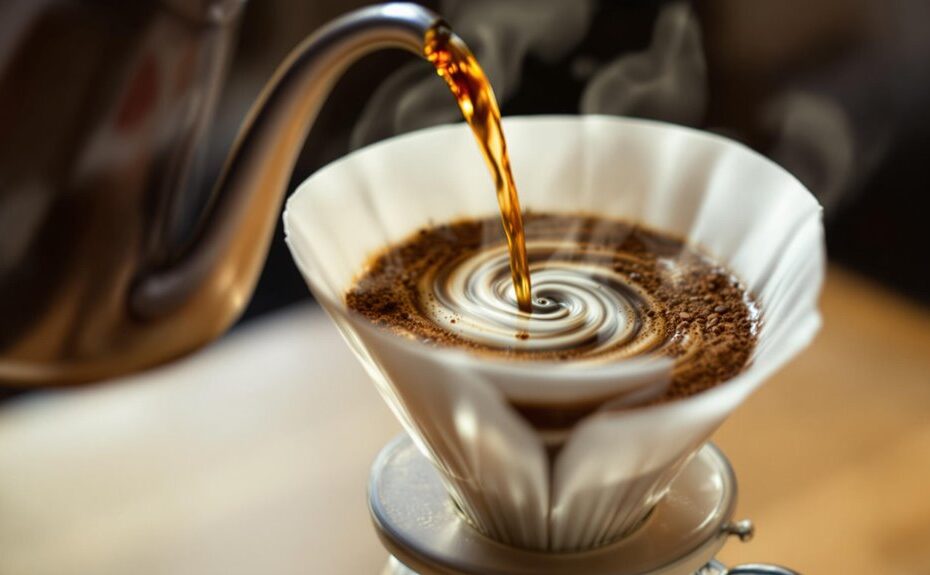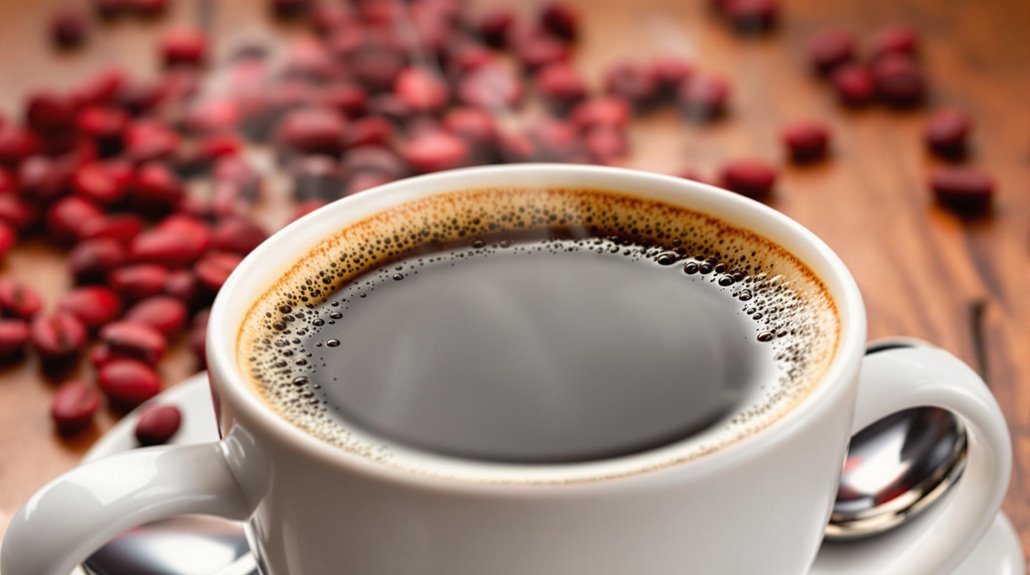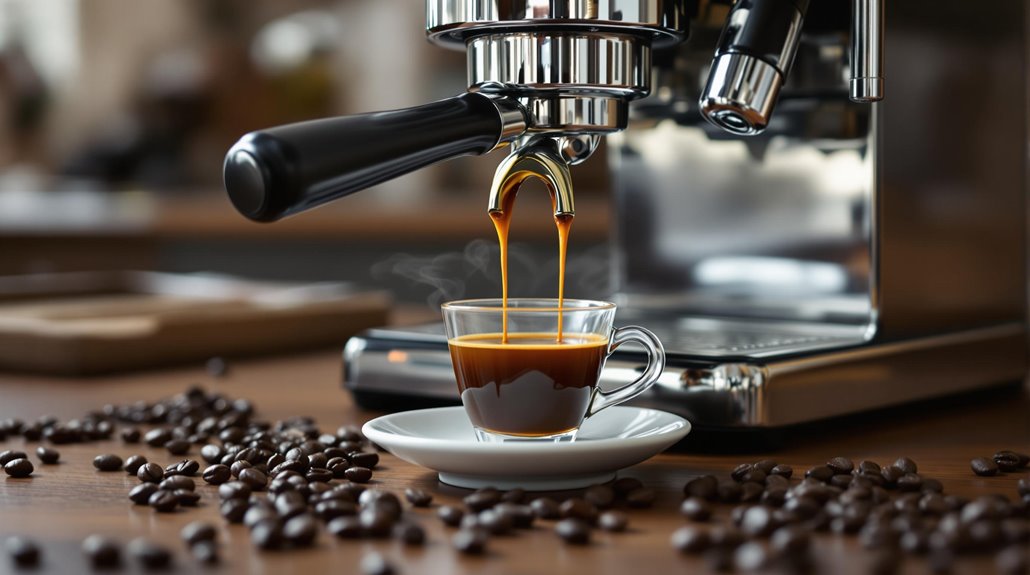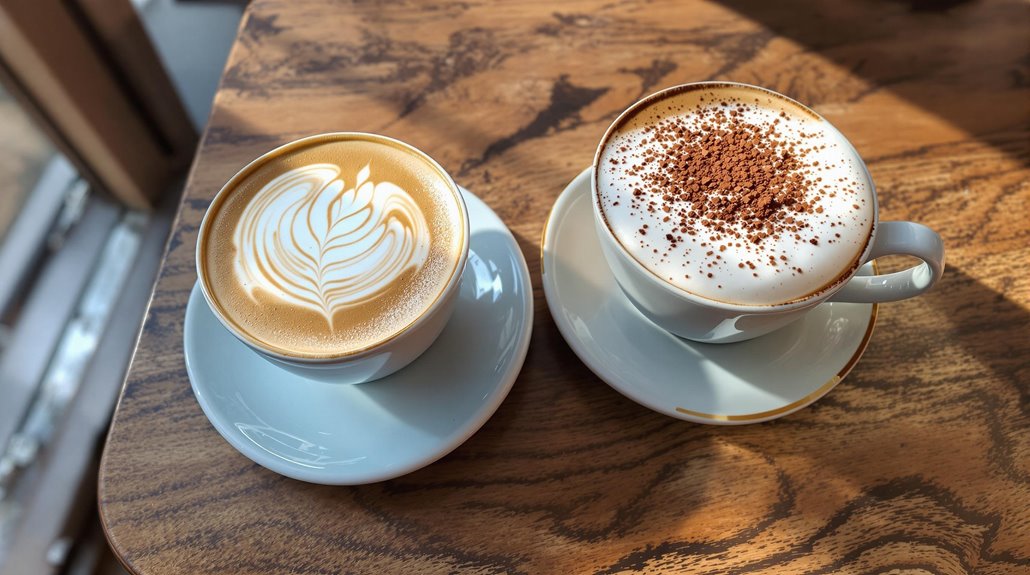







Making pour-over coffee is a delightful way to elevate your morning routine without the fuss of elaborate machinery. To get started, you'll need to gather a few essential tools and ingredients, ensuring you're set up for success. The quality of your coffee and water will greatly influence the final taste, so it's worth paying attention to those details. But before you jump into the specifics, there are some key steps and common pitfalls that can make or break your brew. Curious about what they are?
Key Takeaways
- Start with clean equipment and measure 20 grams of coffee to 320 grams of water for a 1:16 ratio.
- Use a gooseneck kettle for controlled pouring and maintain a brewing temperature between 195°F to 205°F.
- Pre-wet the paper filter to eliminate any papery taste and warm the dripper before adding coffee grounds.
- Bloom the coffee with 60 grams of water for 30-45 seconds, then pour the remaining water in two stages of 130 grams each.
- Monitor the brew time, aiming for 2:45 to 3:30 minutes to achieve optimal extraction.
Understanding Pour-Over Coffee
When it comes to brewing coffee, many enthusiasts swear by the pour-over method for its ability to elevate flavor and aroma. This manual brewing technique gives you precise control over water flow and extraction, allowing you to craft a cup with enhanced clarity and richness. To get started, you'll want to focus on two key elements: the coffee-to-water ratio and the brewing temperature.
For pour-over coffee, aim for a coffee-to-water ratio of about 1:16. This means if you're using 20 grams of freshly ground coffee, you'll need around 320 grams of water. This ratio guarantees balanced extraction, highlighting the unique flavors in your beans. Speaking of beans, always use freshly ground coffee, ideally ground to a consistency similar to fine sea salt. This helps release maximum aroma and flavor.
Next, pay attention to your brewing temperature. The ideal range is between 195°F and 205°F. Following these guidelines, your brew time should fall between 2:45 and 3:30 minutes. By mastering these aspects, you can truly transform your coffee experience and enjoy every sip of your pour-over masterpiece.
Essential Tools and Equipment
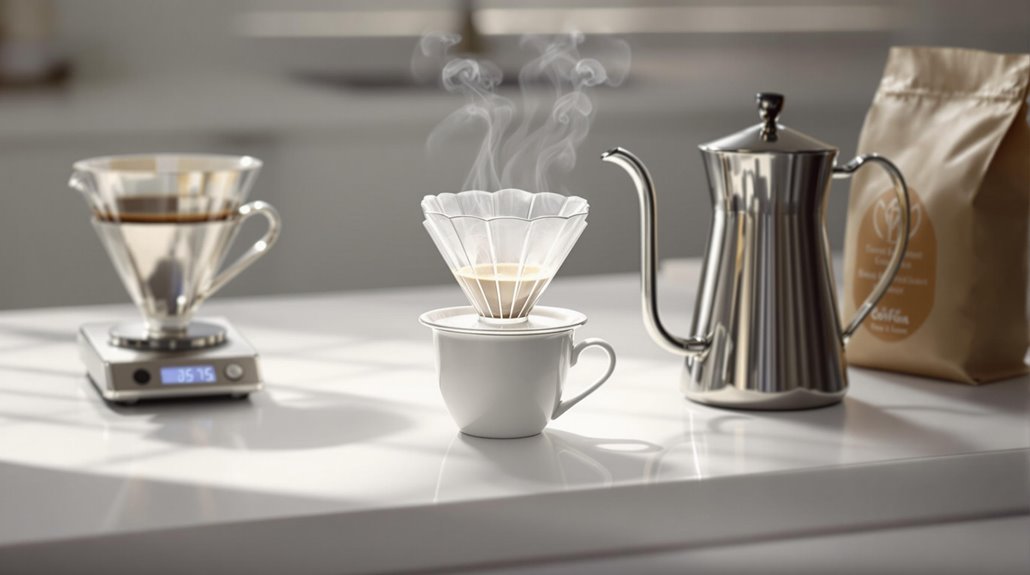
To brew the perfect pour-over coffee, you'll need some essential tools and equipment that elevate your brewing game. From a precise pour-over dripper and a gooseneck kettle to a reliable digital scale and quality filters, each item plays a vital role in achieving that ideal cup. Let's take a closer look at these must-have devices and how they contribute to your coffee experience.
Brewing Devices Overview
In the world of pour-over coffee, having the right brewing devices is key to revealing the full potential of your beans. The first essential device is the pour-over dripper. Popular options like the Hario V60, Chemex, and Kalita Wave each bring unique brewing characteristics that can greatly affect the flavor clarity and body of your coffee. Choose one that suits your taste preferences.
Next, a gooseneck kettle is a must-have for precise pouring control. This allows you to direct the flow of water evenly over the coffee grounds, ensuring even extraction for the best flavor. Don't forget about coffee filters; while paper filters provide a cleaner cup, metal filters can alter the flavor profile. Rinsing paper filters is a good practice to remove any papery taste.
A quality coffee grinder is also essential for achieving a consistent grind size, resembling fine sea salt. This consistency affects extraction and overall flavor. Finally, a digital scale is indispensable for accurately measuring coffee and water, helping you maintain the ideal coffee-to-water ratio, typically around 1:16, for best flavor extraction. With these brewing devices, you're well on your way to mastering pour-over coffee!
Necessary Measuring Tools
The right measuring tools can make all the difference in your pour-over coffee experience. Start with a digital scale, which is vital for accurately measuring both coffee and water. Aim for a coffee-to-water ratio of about 1:16 to achieve peak flavor extraction. This precision guarantees that your brew isn't too weak or too strong.
Next, invest in a quality burr grinder. This tool allows you to achieve a consistent grind size similar to fine sea salt, which is essential for a balanced extraction. A uniform grind helps extract the rich flavors you're after.
Don't forget about a gooseneck kettle! Its design allows for precise pouring control, enabling you to create a steady and even water flow during brewing. This technique enhances extraction and brings out the best flavors.
Finally, a timer is key for monitoring your brewing time. Aim for an extraction range of 2:45 to 3:30 minutes to guarantee your coffee develops its full flavor potential. With these necessary measuring tools, you're well on your way to mastering the art of pour-over coffee.
Filters and Their Types
While selecting the right filter for your pour-over coffee might seem trivial, it can greatly influence the flavor and clarity of your brew. The most common types are paper filters and reusable metal filters. Paper filters yield a cleaner cup by trapping oils and sediment, which can enhance the overall taste. However, it's important to rinse paper filters before use to eliminate any potential papery taste that might affect your coffee's flavor.
If you're using a Chemex brewer, opt for Chemex-specific filters. These filters are thicker than standard paper filters, enhancing the brewing process and flavor extraction. They're designed to fit perfectly with the Chemex's unique shape, ensuring ideal results.
On the other hand, reusable metal filters offer a different experience. They allow more oils to pass through, resulting in a richer flavor profile, but may also produce a slightly grittier cup.
Choosing the Right Coffee
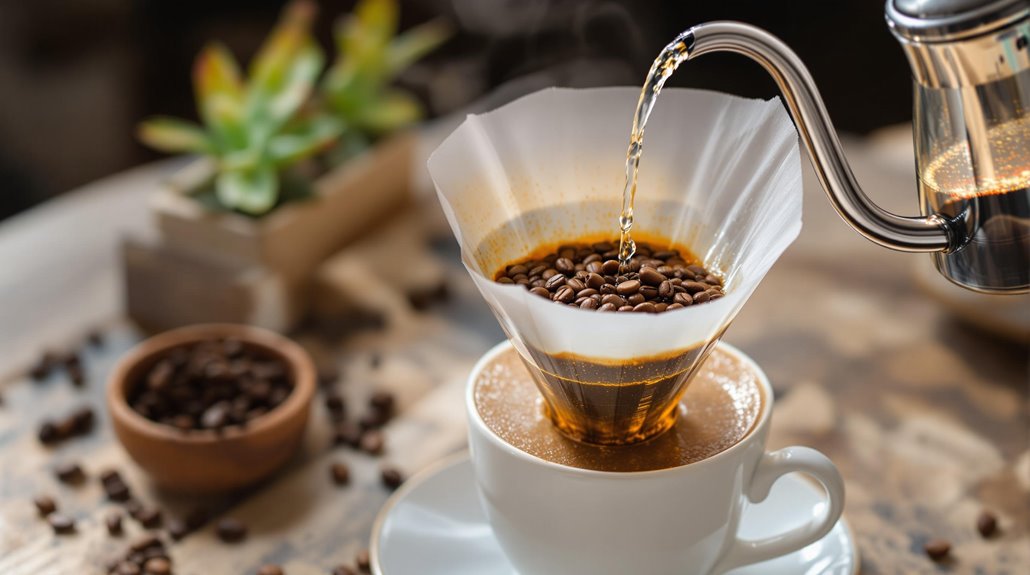
Choosing the right coffee is fundamental for crafting a delightful pour-over experience. Start by selecting specialty single-origin coffee beans. These beans offer unique tasting notes and enhanced freshness compared to mass-produced options, making your brew truly special. Always opt for whole beans and grind them just before brewing. Freshly ground coffee is essential, as it loses about 60% of its aroma within just 15 minutes.
For your grind size, aim for a consistency similar to fine sea salt. This is important for ideal extraction during the pour-over process. Don't forget to experiment with different roast levels. Lighter roasts usually require a higher brewing temperature—up to 210°F—while darker roasts can be brewed at lower temperatures, around 195°F.
Lastly, pay attention to the coffee-to-water ratio. A good rule of thumb is approximately 1:16, which means for every 20 grams of coffee, use about 320 grams of water. This balance guarantees you extract the flavors beautifully, resulting in a cup of coffee that's not only delicious but also perfectly brewed. Happy brewing!
Preparing Your Coffee Grounds
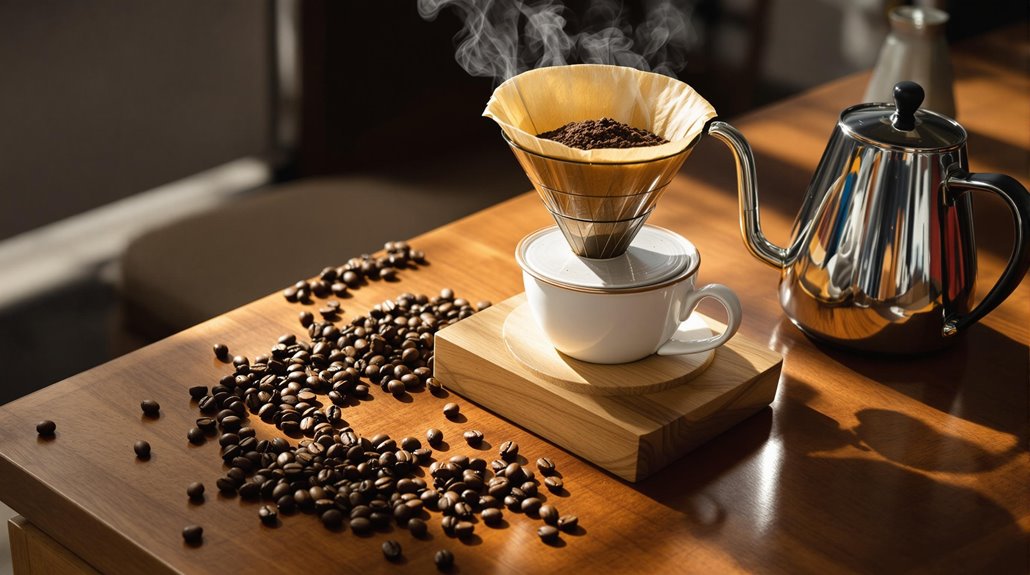
Preparing your coffee grounds is an essential step that greatly influences the quality of your pour-over brew. Start with fresh, whole coffee beans, as they're key to releasing rich flavors. Aim for about 20 grams of coffee for a standard cup, which typically uses 320 grams of water. This maintains the recommended coffee-to-water ratio of 1:16, ensuring a balanced cup.
When it comes to grind size, you'll want a medium to medium-fine consistency, similar to fine sea salt. This grind size optimizes extraction during brewing, preventing the unpleasantness of over or under-extraction. For the best results, use a quality burr grinder; it delivers a consistent grind size, which is vital for flavor balance.
Water Quality and Temperature
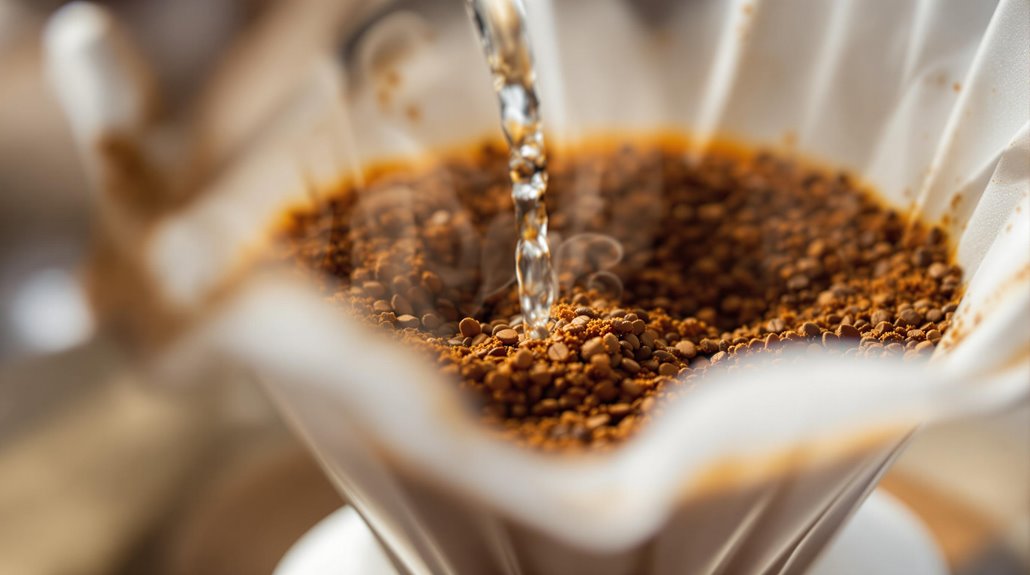
Once you've got your coffee grounds ready, the next step is to pay attention to water quality and temperature, which play a significant role in achieving the perfect pour-over. To start, make sure you're using filtered water. This is vital for ideal flavor, as heavily chlorinated water can negatively impact your brew.
When it comes to brewing temperature, aim for a range between 190°F and 205°F. This temperature range is perfect for extracting the best flavors from your coffee grounds. If the water's too hot—above 205°F—you risk over-extraction, resulting in bitterness. Conversely, water below 190°F may lead to under-extraction, leaving you with a sour taste.
Additionally, it's best to use water with balanced mineral content. Certain minerals can enhance flavor extraction, while distilled or softened water should be avoided, as they can dull the coffee's taste. Finally, consider pre-warming your coffee mug with hot water. This simple step helps maintain the temperature of your brewed coffee, guaranteeing a consistent and enjoyable drinking experience. With the right water quality and brewing temperature, you're well on your way to a fantastic pour-over!
Brewing Process Steps
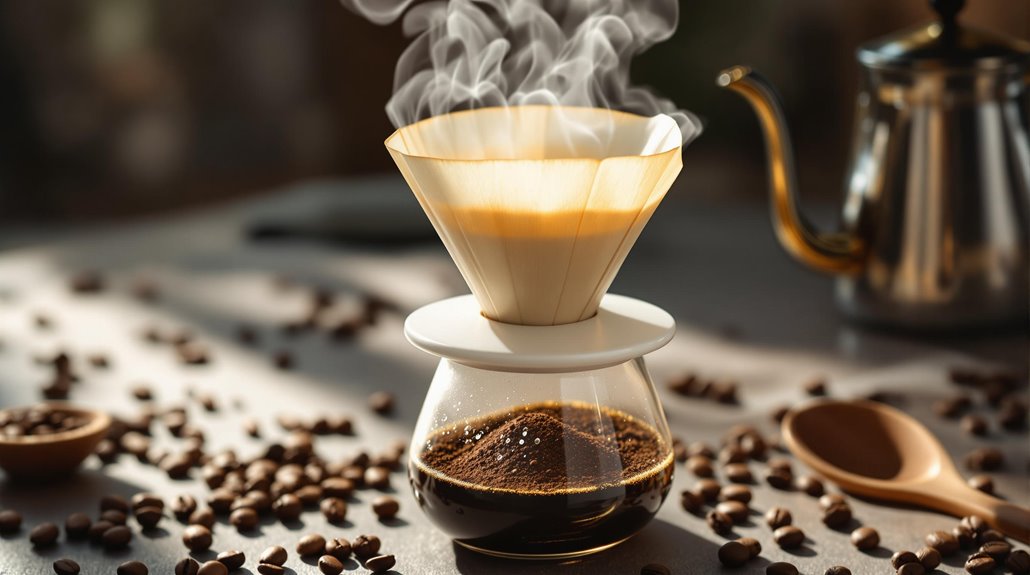
To brew the perfect pour-over coffee, you'll want to start by preparing your equipment and ensuring everything's clean and ready to go. Next, measure out 20 grams of coffee and the right amount of water, keeping in mind the ideal ratios for flavor extraction. With your setup in place, it's time to pour and brew, transforming those ingredients into a delightful cup of coffee.
Prepare Your Equipment
Gather your tools for a perfect pour-over experience, starting with a pour-over dripper like a Chemex or Hario V60, which will be your vessel for brewing. You'll also need a gooseneck kettle for precise control over your pour and a digital scale to measure your coffee and water accurately.
Begin by pre-wetting the paper filter in your dripper with hot water. This step eliminates any papery taste and warms up the brewer, ensuring a better extraction. Next, measure out your coffee; a common starting point is 20 grams, which pairs well with approximately 320 grams (or ml) of water for a 1:16 coffee-to-water ratio.
Now it's time to bloom your coffee. Pour about 60 grams of water over the grounds, letting it sit for 30-45 seconds. This process allows gases to escape and enhances flavor extraction. After blooming, pour the remaining water in a controlled spiral motion, allowing the coffee to draw down before each subsequent pour. Aim for an ideal brew time of around 2:45 to 3:30 minutes for that perfect cup.
Measure Coffee and Water
How can you guarantee the perfect balance of flavors in your pour-over coffee? It starts with measuring the right amount of coffee and water. Aim for a coffee-to-water ratio of approximately 1:16. For every 20 grams of coffee, use about 320 grams (or milliliters) of water to make the ideal brew.
Begin by using a digital scale to measure your coffee with precision. You'll want around 15-20 grams of coffee per cup, but feel free to adjust based on your taste preferences. For the blooming phase, pour approximately 60 grams of water over the coffee grounds. This should be three times the weight of the coffee. Let it sit for 30-45 seconds to enhance flavor extraction.
After blooming, split the remaining water into two pours of 130 grams each. This guarantees even saturation of the coffee grounds. Allow the coffee to draw down between pours. Remember, consistency is key in coffee brewing; maintaining uniform measurements and grind size will lead to reproducible results. Small variations can considerably affect the flavor of your final brew. Enjoy the process and savor each cup!
Pour and Brew
With everything in place, you're ready to start the brewing process. Begin by pre-wetting the paper filter in your dripper to eliminate any papery taste, then position it over your mug or carafe. Next, measure out your coffee, aiming for a grind size similar to fine sea salt, and use a coffee-to-water ratio of approximately 1:16—like 20 grams of coffee to 320 grams of water.
Start the brewing by blooming the coffee grounds. Pour about 60 grams of hot water (between 195°F and 205°F) over the grounds and let it sit for 30-45 seconds. This step helps release carbon dioxide and enhances the flavor of your pour over coffee. After blooming, pour the remaining water gradually in two steady, circular motions, each pour being around 130 grams. Make sure the coffee grounds stay evenly saturated.
Allow the coffee to draw down completely, keeping an eye on the clock. Aim for a total brew time of approximately 2:45 to 3:30 minutes for ideal extraction. Enjoy your deliciously brewed cup of pour-over coffee!
Common Brewing Ratios
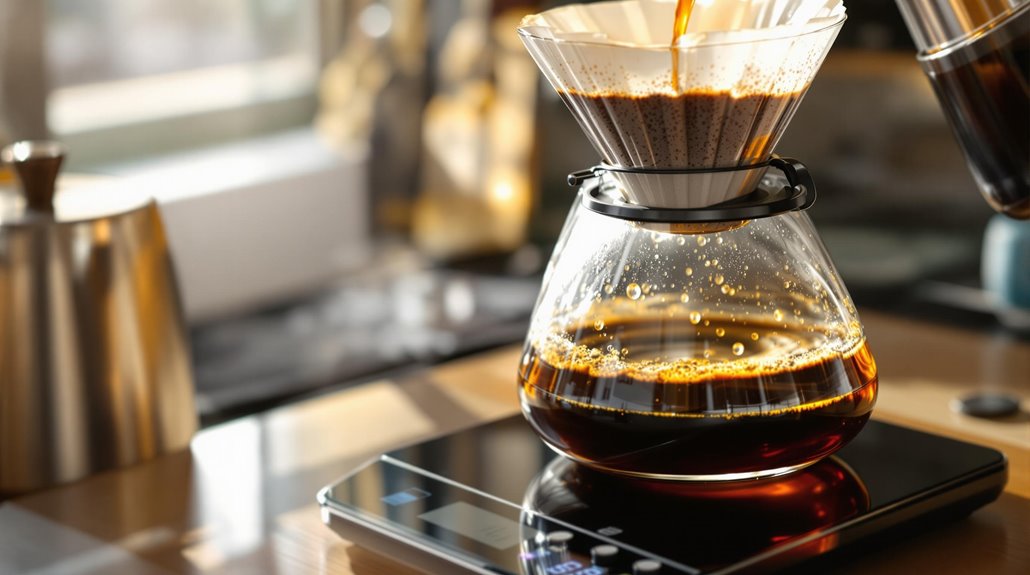
When brewing pour-over coffee, finding the right coffee-to-water ratio is essential for achieving the perfect cup. A common starting point is a ratio of 1:16, meaning for every gram of coffee, you should use 16 grams of water. For instance, if you're using 20 grams of coffee, you'll need about 320 grams (or milliliters) of water to extract ideal flavors.
If you prefer a stronger brew, you might adjust the ratio to 1:14, while those who enjoy a milder cup can try 1:20. Many brewers recommend a ratio of 30 grams of coffee to 500 milliliters of water, which yields a balanced cup that suits most tastes.
Don't be afraid to experiment with these brewing ratios to find the perfect strength and flavor profile that matches your palate. Each adjustment can considerably impact the taste, so take notes on what works best for you. Remember, the goal is to enjoy the process and discover your personal preferences as you refine your pour-over technique. Happy brewing!
Troubleshooting Common Issues

If your pour-over coffee isn't hitting the mark, you might be dealing with weak or bitter flavors that can be easily adjusted. Start by tweaking your grind size or brewing time to enhance extraction, and pay attention to your water temperature to avoid over-extraction. Remember, using quality water also plays an essential role in achieving that perfect cup, so let's troubleshoot together to elevate your brewing game!
Weak Coffee Solutions
Weak coffee can be a frustrating experience for any coffee lover, but there are effective solutions to enhance your brew. First, check your coffee-to-water ratio. A common guideline is 1:16, so for every 20g of ground coffee, you should use about 320g of water. If you've used less coffee, your brew may taste diluted.
Next, pay attention to your grind size. Using a coarse grind can hinder flavor extraction; instead, aim for a medium to medium-fine grind. This adjustment will greatly boost your coffee's strength.
Don't forget to bloom your coffee grounds! Pour double the weight of water (e.g., 60g for 20g of coffee) over the grounds for 30-45 seconds before continuing to brew. This step helps release carbon dioxide and enhances extraction.
Additionally, keep your brew time in check. Aiming for a total brew time of 2:30 to 3:30 minutes will prevent under-extraction. Finally, always use filtered water. Impurities in tap water can weaken the flavor profile, so investing in a good filter is worthwhile for a richer cup.
Bitter Flavor Adjustments
Bitter flavors can ruin a perfectly brewed cup of pour-over coffee, but with a few adjustments, you can easily enhance your brew. Start by examining your grind size; using a coarser grind can help prevent over-extraction, which often leads to that unpleasant bitterness. A finer grind may extract too much flavor too quickly, so aim for a middle ground.
Next, pay attention to your brewing time. Ideally, you want a total brew time of 2:45 to 3:30 minutes. If you brew for too long, you might draw out undesirable flavors that contribute to bitterness.
Water temperature is another vital factor. Make sure your water's between 190°F and 205°F; anything hotter can increase the risk of over-extraction and bitter notes in your coffee.
Lastly, experiment with the coffee-to-water ratio. Starting with a 1:16 ratio, or 20g of coffee to 320g of water, is a great way to strike a balance that minimizes bitterness. If the bitterness persists, try adjusting your pouring technique. Use a gentler spiral motion to maintain even saturation and avoid over-extraction of those coffee grounds.
Water Quality Impact
The quality of water you use can make or break your pour-over coffee experience. To achieve the best flavor extraction, opt for filtered or purified water. This choice helps you avoid undesirable tastes from chlorine or other contaminants that tap water might contain. Remember, water temperature is vital too; keep it between 195°F and 205°F to guarantee ideal extraction. If you use water that's too cold, you risk under-extraction, while water that's too hot can lead to bitterness.
Minerals in water actually enhance flavor extraction, so steer clear of distilled or overly softened water. They can strip away essential minerals that contribute to the taste profile you want.
Also, pay attention to your coffee-to-water ratio. The ideal balance is about 1:16—typically, 20 grams of coffee with around 320 grams of water. This ratio helps create a well-rounded flavor.
Finally, remember that different water sources can lead to variations in taste. Don't hesitate to experiment with various types of water to troubleshoot common issues like weak or overly bitter coffee. A little adjustment can make a big difference in your pour-over brew!
Nutritional Benefits of Coffee
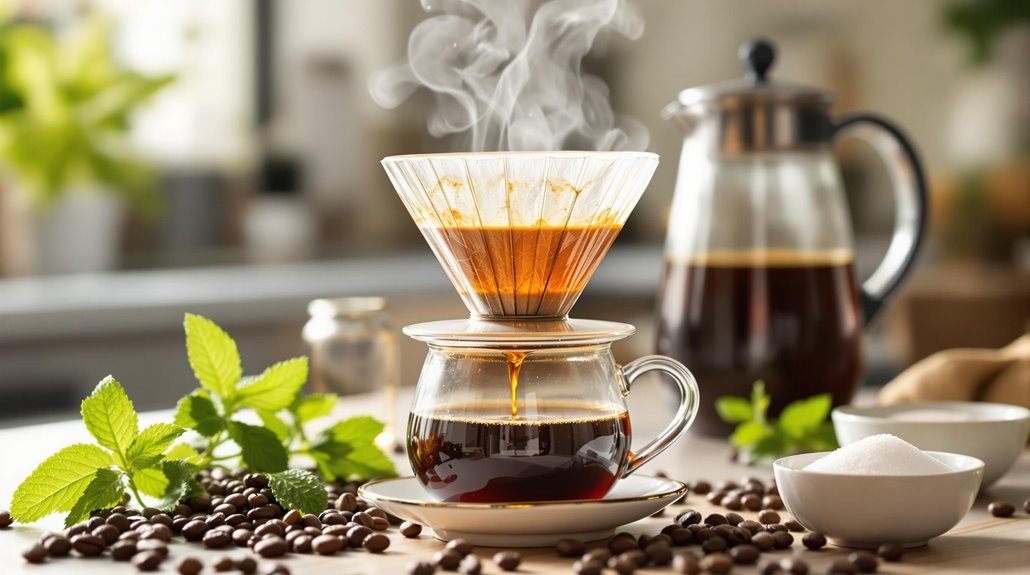
While many people enjoy the rich flavors of pour-over coffee, they might not realize the nutritional benefits it offers. Each standard serving contains only about 2.4 calories, making it a low-calorie beverage choice that fits easily into most diets. When coffee is made using a pour-over method, you're not just savoring a delicious cup; you're also getting about 1.1g of carbohydrates and 0.3g of protein per serving, contributing minimal but meaningful nutrition.
One significant advantage of using paper filters in pour-over brewing is their ability to reduce cholesterol-raising compounds and certain toxins found in coffee. This may offer potential heart health benefits, which is a great reason to enjoy your daily brew. Additionally, coffee is a natural source of caffeine, known to enhance alertness and cognitive function.
Regular coffee consumption is associated with reduced risks of certain diseases, including Parkinson's disease and type 2 diabetes, highlighting its potential health benefits. So, as you indulge in your pour-over coffee ritual, remember it's not just a treat for your taste buds but also a choice that supports your overall health.
Cost Comparison of Brewing Methods
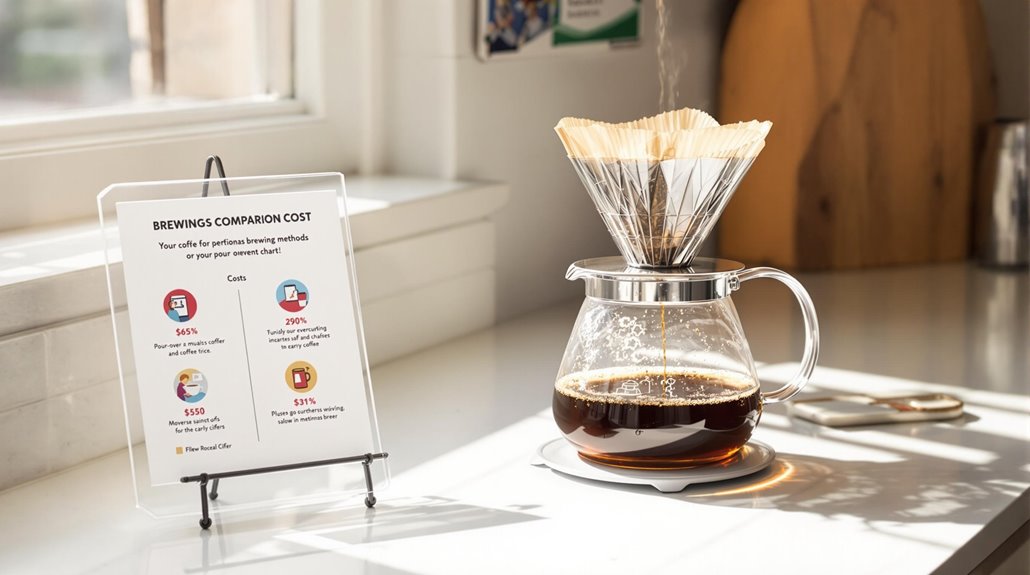
Exploring different brewing methods can reveal surprising cost savings, especially when you compare them to daily coffee shop visits. If you're spending around $3 per cup, you're looking at annual expenses of approximately $1,080. By switching to home brewing, you could save nearly $90 a month!
Investing in pour-over coffee equipment, like a dripper and kettle, costs between $30 and $150, but you'll quickly recoup that expense within a few months. Imagine enjoying high-quality coffee without the price markup at coffee shops. Plus, home brewing allows you to experiment with various beans and brewing methods, enhancing your coffee experience considerably.
When you consider the cost comparison, pour-over coffee stands out as a smart choice. Not only will you enjoy delicious brews tailored to your taste, but you'll also keep your wallet happy. The upfront investment in equipment is minimal compared to the savings you'll reap over time. So, why not embrace home brewing? It's a practical, economical way to savor your favorite beverage while indulging in the craft of making coffee.
Disclosure: As an Amazon Associate, I earn from qualifying purchases.
